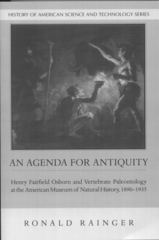2 books about 1890 - 1935

An Agenda for Antiquity
Henry Fairfield Osborn and Vertebrate Paleontology at the American Museum of Natural History, 1890-1935
Ronald Rainger
University of Alabama Press, 1991
How and why vertebrate paleontology flourished at New York’s American Museum of Natural History in the early 20th century
With a main focus on Henry Fairfield Osborn (1857-1935), a prominent scientist and administrator who dominated vertebrate paleontology in that era and played a pivotal role in creating a leading institution and a manor program of research in that field.
Born into a wealthy New York family, Osborn was in a unique position to follow vigorously his scientific interests in vertebrate paleontology and further worldwide science education through use of the considerable social, political, and financial resources at his command. Yet he was able to guide the development of the American Museum of Natural History’s program in vertebrate paleontology in such a manner as to avoid conflict with the values and beliefs associated with the interests of the upper-class elite who supported the program.
His ties to a wide network of influential figures, including the trustees of the American Museum, provided him with the political and financial resources necessary to build a major program in vertebrate paleontology. An ambitious and energetic man, Osborn took advantage of those opportunities to promote his field of study and to establish himself as a leading administrator at the American Museum, Colombia University, and the New York Zoological Society.
With a main focus on Henry Fairfield Osborn (1857-1935), a prominent scientist and administrator who dominated vertebrate paleontology in that era and played a pivotal role in creating a leading institution and a manor program of research in that field.
Born into a wealthy New York family, Osborn was in a unique position to follow vigorously his scientific interests in vertebrate paleontology and further worldwide science education through use of the considerable social, political, and financial resources at his command. Yet he was able to guide the development of the American Museum of Natural History’s program in vertebrate paleontology in such a manner as to avoid conflict with the values and beliefs associated with the interests of the upper-class elite who supported the program.
His ties to a wide network of influential figures, including the trustees of the American Museum, provided him with the political and financial resources necessary to build a major program in vertebrate paleontology. An ambitious and energetic man, Osborn took advantage of those opportunities to promote his field of study and to establish himself as a leading administrator at the American Museum, Colombia University, and the New York Zoological Society.
[more]

The Masculine Woman in America, 1890-1935
Laura L. Behling
University of Illinois Press, 2001
The Masculine Woman in America, 1890-1935 examines how the suffrage movement's efforts to secure social and political independence for women were translated by a fearful society into a movement of unnatural "masculinized" women and dangerous "female sexual inverts."
Scrutinizing depictions of the masculine woman in literature and the popular press, Laura L. Behling explicates the literary, artistic, and rhetorical strategies used to eliminate the "sexually inverted" woman: punishing her by imprisonment or death; "rescuing" her into heterosexuality; subverting her through parody; or removing her from society to some remote or mystical place. Behling also shows how fictional same-sex relationships in the writings of Henry James, Charlotte Perkins Gilman, Gertrude Stein, and others conformed to and ultimately reaffirmed heterosexual models.
The Masculine Woman in America, 1890-1935 demonstrates that the women's suffrage movement did not so much suggest alternatives to women's gender and sexual behavior as it offered men and women afraid of perceived changes a tangible movement on which to blame their fears. A biting commentary on the insubstantial but powerful ghosts stirred up by the media, this study shows how, though legally enfranchised, the new woman was systematically disfranchised socially through scientific theory, popular press illustrations, and fictional predictions of impending sociobiological disaster.
Scrutinizing depictions of the masculine woman in literature and the popular press, Laura L. Behling explicates the literary, artistic, and rhetorical strategies used to eliminate the "sexually inverted" woman: punishing her by imprisonment or death; "rescuing" her into heterosexuality; subverting her through parody; or removing her from society to some remote or mystical place. Behling also shows how fictional same-sex relationships in the writings of Henry James, Charlotte Perkins Gilman, Gertrude Stein, and others conformed to and ultimately reaffirmed heterosexual models.
The Masculine Woman in America, 1890-1935 demonstrates that the women's suffrage movement did not so much suggest alternatives to women's gender and sexual behavior as it offered men and women afraid of perceived changes a tangible movement on which to blame their fears. A biting commentary on the insubstantial but powerful ghosts stirred up by the media, this study shows how, though legally enfranchised, the new woman was systematically disfranchised socially through scientific theory, popular press illustrations, and fictional predictions of impending sociobiological disaster.
[more]
READERS
Browse our collection.
PUBLISHERS
See BiblioVault's publisher services.
STUDENT SERVICES
Files for college accessibility offices.
UChicago Accessibility Resources
home | accessibility | search | about | contact us
BiblioVault ® 2001 - 2024
The University of Chicago Press









